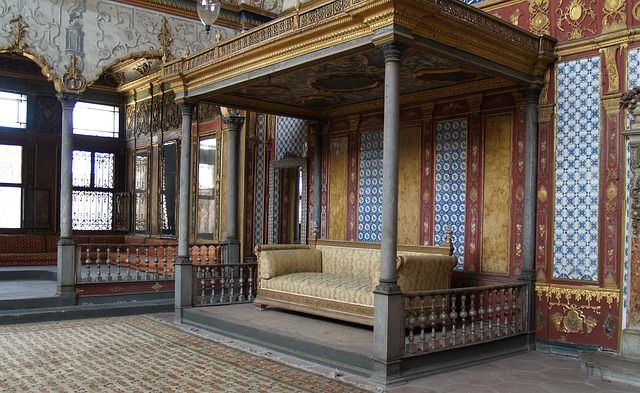
The harem was not a place of pleasure and entertainment, as reflected in many places, but an educational institution. It consisted of beautiful and intelligent girls brought from different parts of the world by the spoils of war, the slave trade, or by her own family. Some high-ranking families voluntarily placed their daughters in the Harem so that they could get a good education and rise in the Palace.
When concubines, mostly girls of Balkan countries, Georgian, Circassian or Russian origin, were admitted to the Palace, they were subjected to a special examination prepared as the Girls' Aghas and were separated according to their beauty, talent and abilities.
Their names were given by the Girls' Agha after this exam, and they would call them by that name in their next life. If the girls who entered the harem belonged to other religions, they were taught Islam and the Qur'an first. After a rigorous education, they would learn imaginable things such as eloquence, literature, music and dance during their education here.
Although the concubines in the harem had to obey the Sultan, none of them were girls who were locked up here for the rest of their lives. If one of them wanted to leave the Harem for any reason, he would write a letter to the Sultan and explain the reason for wanting to leave.
Harem literally means "untouchable, holy".
There was a hierarchical order in the management of the harem. Since it was the sultan's private place, it was meticulously managed. The girls who joined the harem were called "novices". In addition to Turkish and Islamic customs, hand skills such as sewing and embroidery were taught, and girls who completed their novice period became "concubines".
Any of the concubines could marry someone from Enderun (the institution that trained statesmen for the Ottoman administration) if they wanted to. The girl who was promoted from concubine would be a ''gedikli". After this promotion, they were put into the service of the Sultan, and they served for the Sultan, such as cooking and washing his clothes.
Among the gedikli girls, the Sultan's relationship was now called "Haseki". Haseki are the favorites and women of the Sultan. Each of those who were the Sultan's women as Haseki were given a flat. Hasekis who gave birth to children among them would have more privileges.
According to the hierarchical administration, each concubine had to listen to the one who was more promoted than her, and each concubine had a certain salary.
Eunuchs determined all the administrative staff and security in the Harem. These were men who were stripped of all sexuality by castration, who provided protection and discipline. The eunuchs were under the direction of the maiden aghas and were responsible for such things as the courtesy of the rooms and the distribution of salaries.
No outsider men or women were allowed into the Harem. The Sultan's mother ruled the entire Harem. When the sultan married a girl of concubine origin, he generally did not marry. The wedding of Sultan Suleiman to his concubine of Ukrainian origin, Hürrem Sultan, was an exception.
Harem is one of the most secret institutions of the Ottoman Empire. There is very limited information about harems. Contrary to Western discourses, it is not a world of pleasure. The girl in the harem was invisible to the Sultan until she received her gedikli status. Although the Harem was located within the Palace, its entrances and exits were independent of the Palace and the Sultan.
When the sultan died or left the throne for any other reason, the entire Harem was moved to the old Palace and the new Harem was established. If the sultan died, his mother, who ran the Harem, would leave.
Hürrem Sultan, who stood out with her beauty, courage and intelligence among the harem concubines, started the period known as the women's reign by having a say in the Ottoman Empire. Mihrimah Sultan, daughter of Hürrem Sultan and II. During the reign of Selim, Nur Banu Sultan had a say in Ottoman Politics.
When personal interests came to the fore instead of state interests, he had power over Harem Pashas, Grand Viziers, Viziers and Yeni Çeris, and ensured the replacement of Grand Viziers and even Sultans.
It was Sultan Genç Osman who realized the intrigues in the Harem and attempted to abolish the Harem. Young Osman, who wanted to make innovations such as marrying Turkish family girls instead of marrying one of the sultans from the Harem, was murdered by the Harem-supported Janissaries in 1622 and the efforts to abolish the Harem were interrupted.
After this event, the period of Kösem Sultan, which was a State within a State, began. Harem Kösem, which became an inviolable structure even by the Sultan, had a say in the Ottoman administration for nearly 20 years together with the Sultan.
The Harem, which continued its existence until the reign of the last Ottoman Sultan, Vahdettin, was disbanded by the Sultan Vahdettin, on the grounds of changing conditions. While the girls with families were handed over to their families, those who did not have a family were expelled from the Harem by giving them enough money to last their entire lives.
Sources used in the preparation of the article;
https://www.tarihiolaylar.com/galeriler/osmanli-da-bilinmeyen-yonleriyle-harem-kulturu-685